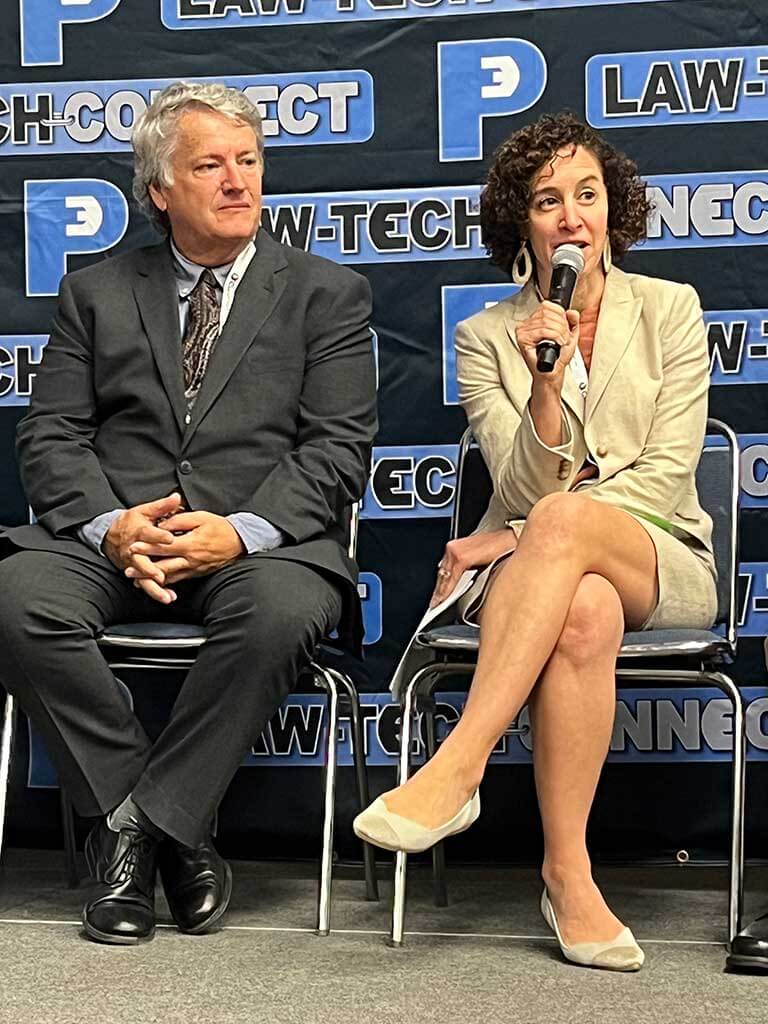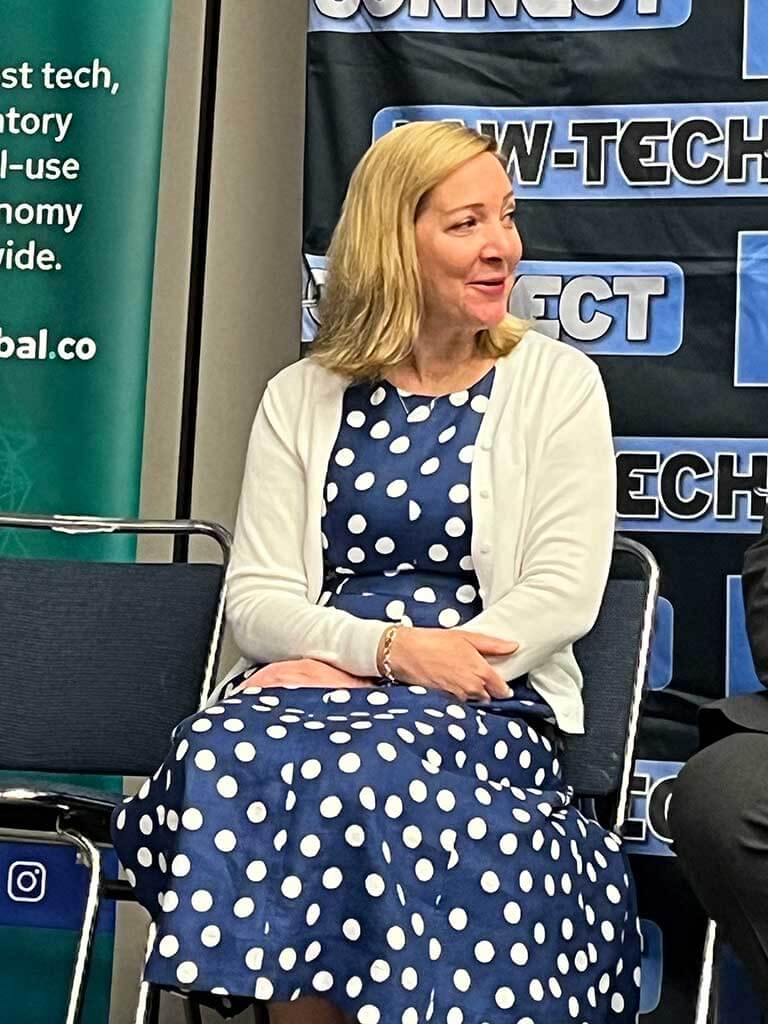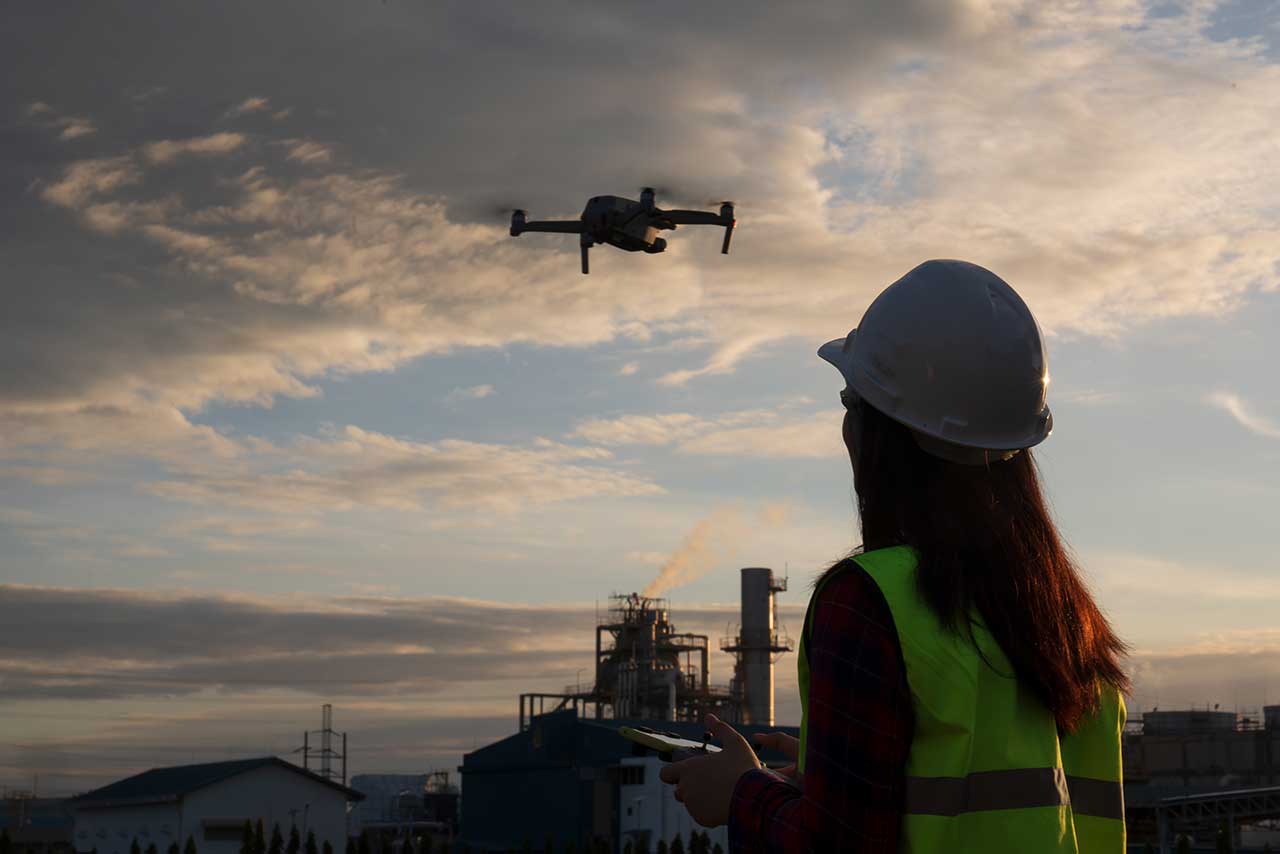The energy sector demands regulatory compliance. The promise of technological autonomy has reshaped how oil, gas and utility companies operate. A virtuous circle has formed around the requirements and the technology that helps to meet them: compliance drives innovation and innovation, in turn, enhances compliance. This creates a feedback loop that has redefined the industry’s approach to safety, efficiency and environmental stewardship.
This dynamic was on full display at the recent Law Tech Connect panel, “Big, Big Energy: The Virtuous Circle of Compliance and Autonomy in the Energy Sector,” where leaders from across the energy and legal landscapes gathered to dissect the challenges and opportunities facing the industry. Their insights revealed a sector navigating regulatory flux, technological leaps and a relentless push for operational excellence. Read on to learn more.

Navigating a Shifting Regulatory Landscape
The regulatory environment, particularly for methane emissions, has evolved dramatically. While the Clean Air Act of 1970 established the legal framework for regulating air pollutants, for decades, the EPA did not regulate greenhouse gases (GHGs) like methane under this law. In 2007, the Supreme Court’s decision in Massachusetts v. EPA clarified that greenhouse gases are indeed “air pollutants” under the Clean Air Act, and that the EPA had the authority—and, if it found these emissions endangered public health or welfare, the obligation—to regulate them.
However, the Massachusetts case specifically addressed emissions from new motor vehicles, not stationary sources like power plants or oil and gas facilities. After the Court’s decision, the EPA made an “endangerment finding” in 2009, concluding that greenhouse gases, including methane, endangered public health and welfare. This finding triggered regulatory actions for both mobile and stationary sources under the Clean Air Act.
Subsequent administrations have taken divergent approaches on methane regulation. The Biden administration introduced robust methane regulations. Before that, the initial Trump administration moved to peel back some of those measures. The question now is what will happen under Trump 2.0?
Emily Mallon, energy regulatory partner at Akin, captured the complexity of the current moment. “There’s been a lot of change in the past six months in terms of how we think about methane emissions,” she said. “But just because there’s been change does not mean that we don’t think about it. In fact, we have to keep thinking about it.”
Mallon further explained, “Some of those regulations came out of the Inflation Reduction Act obligations. We’re going to see some peeling back of the Inflation Reduction Act. One example is this what’s called the waste emissions charge… that fee provision was just repealed.” She continued, “But at the same time, the underlying need to report your emissions hasn’t gone away.”
A patchwork of state-level rules further compound regulatory uncertainty. Mark McKinnon, aviation law partner at Fox Rothschild, noted, “States even predated some of the EPA regulations. Colorado is a good example. They passed their statute back in 2014… it’s even broader than some of the federal regulations because most of the federal regulations and other state regulations usually start with emissions from wells of a certain date or size. In Colorado, all the wells in the state have to be inspected and meet emissions requirements.”
The result is a landscape where companies must navigate overlapping state and federal mandates, often with shifting enforcement priorities. Yet, as Suzanne Lemieux of the American Petroleum Institute (API) observed, “The uncertainty that has been created recently with the 150-plus executive orders is confusing, but I think the industry is committed to methane reductions.”

Compliance as a Catalyst for Innovation
Despite the regulatory headwinds, the industry’s commitment to compliance has become a springboard for technological innovation. Lemieux highlighted the API’s Environmental Partnership, launched in 2016 to drive methane and volatile organic compound (VOC) reductions.
“We sell methane in the oil,” she said. “That’s natural gas, so no one wants to lose it. No one wants to have releases or significant flow downs. The industry is committed to emissions reductions. We’ve seen a significant reduction in methane emissions in the last ten years.”
Technology has become central to these efforts. Richard Nasmith, Senior Vice President at Volatus Aerospace, explained how drones and robotics have revolutionized inspection and monitoring. “The drones became and are becoming far more capable than they ever were. The company I’m with right now can operationally control drones from an operation center anywhere in the world. We just have to convince those government agencies that what we do is safer than safe. But we have to comply with the regulations,” he said.
The deployment of drones, lidar,and other sensors allows companies to gather high-resolution data on emissions, infrastructure integrity and environmental impacts. Smith noted, “What’s changed is how you can get access to that information, how the data is generated, certainly, but how you get access to the data. You don’t now have to be a PhD in engineering to log in and look at data and figure out how it’s used,” he noted.
Real-World Applications: From Methane Detection to Predictive Maintenance
The practical impact of these technologies is evident in the field. Tedman Jess, Senior Aviation Advisor for Drones at Suncor Energy, described how his company has integrated drones into its vast operations. “We primarily operate in the Alberta oilsands… our sites in northern Alberta are about 1800 square kilometers.” The company is also switching its fleets of dump trucks to autonomous haul trucks. “We are trying to combine the drone technology within our huge infrastructure, which is massive,” Jess said.
Jess detailed a “crawl, walk, run” approach to drone adoption. Suncor started with external vendors and gradually built up an internal capacity. “We now operate a hybrid drone program. The majority of our flights are done by vetted vendors, who are embedded at our sites. But we have also started our internal pilot program. I currently have 53 pilots who have their advanced pilot certificate from Transport Canada and are now using a drone basically as part of their toolkit,” he explained.
Survey flights provide a primary use case. Drones map mine changes and monitor haul roads for wear and tear. Jess shared, “We’re scanning 50km of our roads and our mines. That’s being put through a machine learning algorithm… we are able to then map the changes that need to happen.” This includes the banks of the curves, the crown of the road and all the differences on them. “We’re able to get that information from the time we collect the data—it’s less than a week—which is still not ideal. Because I always say it’s quality data in a timely manner, which can then help us make informed business decisions,” he said.
Beyond surveying, drones have transformed environmental compliance. Suncor has replaced manual wildlife sweeps with drone-based thermal imaging. This has dramatically improved accuracy and efficiency.
“We finally got permission from the Alberta Energy Regulator to use a drone with thermal scan to do it. The Alberta Energy Regulator was blown away by how much more wildlife we found with the drone. Now we are able to use a drone on those wildlife sweeps, as long as the pilot is a biologist or the biologist is sort of off their shoulder,” Jess explained.

The Roadblocks: Regulation, Weather and Security
While the promise of autonomy seems clear, significant barriers remain. Regulatory frameworks, particularly in the United States, have struggled to keep pace with technological advances.
Lemieux pointed out, “We really want to see a lot more drone capability. We know it’s possible. It’s the regulatory framework that is inhibiting us at this point. And so hopefully again, if the (Part 108 beyond visual line of sight or BVLOS) rule comes out…we comment… it’s going to be like another year and a half with FAA timelines at least.”
Extreme weather presents another challenge, especially for operations near the Arctic Circle. Jess explained, “For three months of the year, we could be in -40 Celsius or Fahrenheit. Most drones are actually made for temperate climates… for us to be able to use a platform, it has to be able to perform in our conditions. There was a period of two weeks where we were not really able to fly any drones on site because the temperature was too cold. If we can’t do that, then it’s back to traditional manned ways, putting people in higher risk situations.”
Security concerns have also arisen, particularly around critical infrastructure. Lemieux recounted the evolution of the 2016 FAA Reauthorization Act Section 2209, which aims to restrict drone flights over critical infrastructure. “We wanted to just potentially have restrictions over critical infrastructure that you wouldn’t fly a drone into a refinery and cause an industrial accident. That was the intention.” Congress, however, added Disney and the railroads and other folks “piled on,” she noted. The FAA has finally drafted an implementation rule, but no one seems to know what it looks like.
These security concerns appear to be global. Jess, speaking of his experiences in Canada, added, “We have tested out some systems that would identify drones. We cannot restrict the airspace. Unfortunately…we have a lot of rogue drones. There’s clearly people that are out there breaking the law, but our only recourse is to inform Transport Canada and call the Royal Canadian Mounted Police (RCMP), and the RCMP are not going to come out and look at a drone,” he lamented.
The Expanding Universe of Use Cases
While methane detection and inspection have dominated the conversation, the range of drone applications in energy continues to rapidly expand. Smith highlighted the growing use of drones in the power line industry. “Drones can carry the majority of sensors, although they’re purpose built, to do the laser scanning, high-resolution optical, you can carry thermal detection units… These are systems that can see things that the human eye can’t see. Look for hot spots. You can carry ground penetrating radar to do some subterranean work,” he said.
Suncor, as Alberta’s third-largest electricity producer, is piloting drone-based inspections of transmission lines. Jess noted, “We are doing a pilot proof of concept using a drone with a bunch of sensors on it so that we can…do one flight as opposed to multiple. So vegetation encroachment, insulation and corona detection. It’s happening where it was traditionally done by a person in a helicopter shooting a handheld instrument out the window.”
Lemieux pointed to additional innovations in solar farm inspections. “There was a company using machine learning and going over solar farms to detect the single panel that was out, where normally you’d have someone drive miles and have to go individually to each panel to figure out which was the one that was out. Through thermal imaging, they could fly the drone and do it continuously to detect that anomaly,” she explained.
Other applications include internal tank inspections, offshore platform inspections using robotics and predictive maintenance enabled by high-frequency data collection. As Lemieux put it, “The drone is the tool. It’s a tool in the toolbox…And even with the drone, it’s about the data. What can you do with the data? Whether it’s surveillance, whether it’s detection, how are we using it and how can we create efficiencies?”

The Future: Toward a New Standard of Autonomy and Compliance
Looking ahead, the panelists agreed that the interplay between compliance and autonomy will only intensify. The regulatory map may be murky, but the direction is clear: technology will continue to drive improvements in safety, efficiency and environmental performance, even as companies and regulators grapple with uncertainty.
Smith offered a pragmatic perspective. “The best advice in terms of drones and services comes from the experts, the people that fly them, that integrate the data. Drone technology is expanding really, really quickly. Nobody owns the space of ‘we have the best end to end.’ There’s some remarkable products that are coming. Costs are going to be a significant thing, especially with tariffs,” he said but, “There are remarkable opportunities coming.”
Mallon underscored the importance of proactive monitoring, regardless of regulatory flux. “Even if the regulatory scheme is varying, as an operator, you want to know what’s going on in your system and you don’t want it coming out on the front page of the Wall Street Journal…” she said. “There is this really great trade press article about a facility in Memphis, Tennessee, where an environmental NGO (non-governmental organization) flew a drone over this facility to show how much methane was actually being emitted…maybe putting the regulator to shame, maybe putting the operator to shame. But it was a big deal.”
Jess reflected on the Canadian experience, where regulatory certainty has just begun to unlock new possibilities. There has been “a promise that the regulations for BVLOS were always coming. Now in November, we will be able to have simplified low risk BVLOS flights being able to be performed in Canada. That’s really going to open up the world for us…more long pipeline scans. It’s sort of a paradigm shift for us. It’s a great time to have partners and vendors to be able to do that before we adopt that internally,” he opined.
The Virtuous Circle in Action
The energy sector’s journey toward a virtuous circle of compliance and autonomy remains far from complete. But the momentum is undeniable. Regulatory requirements have pushed companies to adopt new technologies, while those technologies have enabled higher standards of compliance and operational excellence. The result is a sector that not only has adapted to change but continues to actively shape its own future.
As Lemieux succinctly put it, “No one wants emissions, no one wants dirty air. We all want clean air. I think that’s a common goal. And I think that we’re going to see that moving forward. The emissions reductions through the use of drones is something that we see as a huge win. And it’s happening today.”
The virtuous circle continues to spin, and the energy sector stands poised to harness its big, big energy for a cleaner, safer and more autonomous tomorrow.Watch the video of the panel “Big, Big Energy: The Virtuous Circle of Compliance and Autonomy in the Energy Sector” held at Law-Tech Connect 2025 during XPONENTIAL here.
By: Dawn Zoldi

